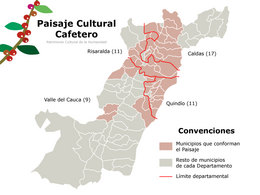
| UNESCO World Heritage Site | |
|---|---|
 | |
| Location | Colombia |
| Criteria | Cultural: (v), (vi) |
| Reference | 1121 |
| Inscription | 2011 (35th Session) |
| Area | 141,120 ha (348,700 acres) |
| Buffer zone | 207,000 ha (510,000 acres) |
| Coordinates | 5°28′18″N 75°40′54″W / 5.47167°N 75.68167°W |
Coffee production in Colombia has a reputation for producing mild, well-balanced coffee beans.[1][2][3][4] Colombia's average annual coffee production of 11.5 million bags is the third total highest in the world, after Brazil and Vietnam, though highest in terms of the arabica bean.[5][6][7][8] The beans are exported to United States, Germany, France, Japan, and Italy.[9] Most coffee is grown in the Colombian coffee growing axis region, while other regions focus on quality instead of volumes, such as Sierra Nevada de Santa Marta. In 2007, the European Union granted Colombian coffee a protected designation of origin status.[10] In 2011, UNESCO declared the "Coffee Cultural Landscape" of Colombia, a World Heritage site.[11]
The coffee plant had spread to Colombia by 1790.[12] The oldest written testimony of the presence of coffee in Colombia is attributed to a Jesuit priest, José Gumilla. In his book The Orinoco Illustrated (1730), he registered the presence of coffee in the mission of Saint Teresa of Tabajé, near where the Meta river empties into the Orinoco. Further testimony comes from the archbishop-viceroy Caballero y Gongora (1787) who registered the presence of the crop in the north east of the country near Giron (Santander) and Muzo (Boyaca) in a report that he provided to the Spanish authorities.
- ^ Charles W. Bergquist (1 October 1986). Coffee and Conflict in Colombia, 1886–1910. Duke University Press. p. xvii. ISBN 0822307359.
- ^ Philip Kotler (11 December 2012). Kotler on Marketing. Simon and Schuster. p. 104. ISBN 9781471109560.
- ^ Meister (10 June 2013). "What Do Coffees from the Major Growing Regions Taste Like?". seriouseats.com.
- ^ Patricia McCausland-Gallo (2004). Secrets of Colombian Cooking. Hippocrene Books. p. 3. ISBN 9780781810258.
- ^ "World coffee trade (1963–2013)" (PDF). International Coffee Association. 24 February 2014.
- ^ "History of Coffee in Colombia". equalexchange.coop.
- ^ "Coffee Market and Colombia". american.edu. May 2001. Archived from the original on 10 June 2010. Retrieved 12 August 2010.
- ^ "World's Top 10 Coffee-Producing Countries in 2010–2011". Bloomberg. 19 August 2011.
- ^ "TED Case Study: Coffee Market and Colombia" (in Spanish). American University, The School of International Service. 13 August 2001. Archived from the original on 10 June 2010. Retrieved 11 August 2010.
- ^ "European Union gives to 'Café de Colombia' the protected denomination of origin" (in Spanish). Terra. 13 August 2007. Archived from the original on 8 May 2008. Retrieved 22 April 2008.
- ^ Cite error: The named reference
UNESCOwas invoked but never defined (see the help page). - ^ Kalayya Krishnamurthy (2002). Pioneers in scientific discoveries. Mittal Publications. p. 49. ISBN 9788170998440.
